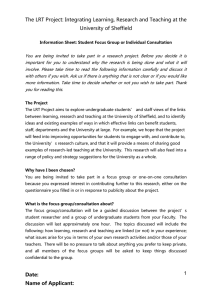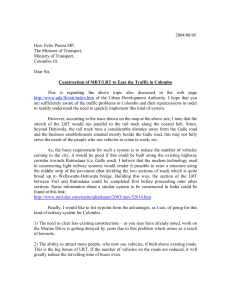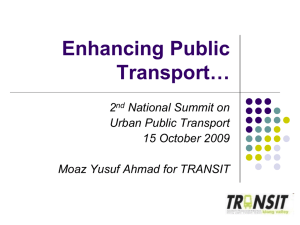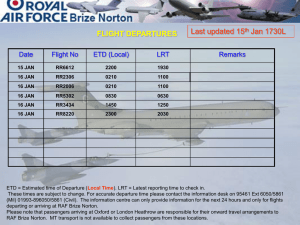5.0 financial analysis and comparison of alternatives
advertisement
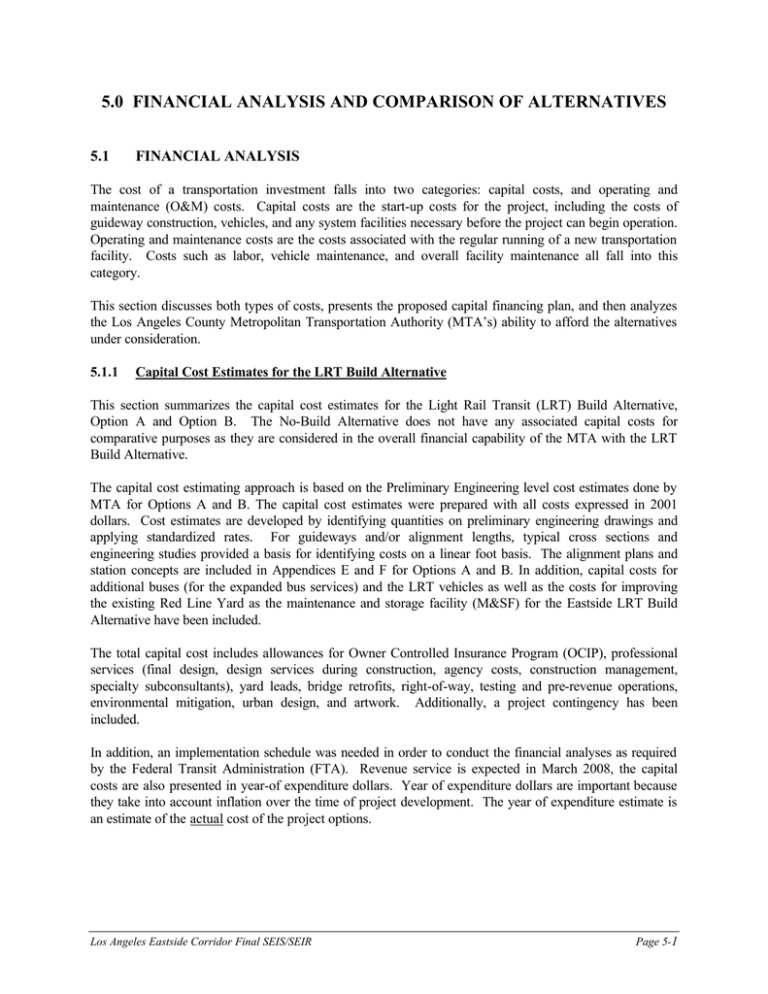
5.0 FINANCIAL ANALYSIS AND COMPARISON OF ALTERNATIVES 5.1 FINANCIAL ANALYSIS The cost of a transportation investment falls into two categories: capital costs, and operating and maintenance (O&M) costs. Capital costs are the start-up costs for the project, including the costs of guideway construction, vehicles, and any system facilities necessary before the project can begin operation. Operating and maintenance costs are the costs associated with the regular running of a new transportation facility. Costs such as labor, vehicle maintenance, and overall facility maintenance all fall into this category. This section discusses both types of costs, presents the proposed capital financing plan, and then analyzes the Los Angeles County Metropolitan Transportation Authority (MTA’s) ability to afford the alternatives under consideration. 5.1.1 Capital Cost Estimates for the LRT Build Alternative This section summarizes the capital cost estimates for the Light Rail Transit (LRT) Build Alternative, Option A and Option B. The No-Build Alternative does not have any associated capital costs for comparative purposes as they are considered in the overall financial capability of the MTA with the LRT Build Alternative. The capital cost estimating approach is based on the Preliminary Engineering level cost estimates done by MTA for Options A and B. The capital cost estimates were prepared with all costs expressed in 2001 dollars. Cost estimates are developed by identifying quantities on preliminary engineering drawings and applying standardized rates. For guideways and/or alignment lengths, typical cross sections and engineering studies provided a basis for identifying costs on a linear foot basis. The alignment plans and station concepts are included in Appendices E and F for Options A and B. In addition, capital costs for additional buses (for the expanded bus services) and the LRT vehicles as well as the costs for improving the existing Red Line Yard as the maintenance and storage facility (M&SF) for the Eastside LRT Build Alternative have been included. The total capital cost includes allowances for Owner Controlled Insurance Program (OCIP), professional services (final design, design services during construction, agency costs, construction management, specialty subconsultants), yard leads, bridge retrofits, right-of-way, testing and pre-revenue operations, environmental mitigation, urban design, and artwork. Additionally, a project contingency has been included. In addition, an implementation schedule was needed in order to conduct the financial analyses as required by the Federal Transit Administration (FTA). Revenue service is expected in March 2008, the capital costs are also presented in year-of expenditure dollars. Year of expenditure dollars are important because they take into account inflation over the time of project development. The year of expenditure estimate is an estimate of the actual cost of the project options. Los Angeles Eastside Corridor Final SEIS/SEIR Page 5-1 5.0: Financial Analysis and Comparison of Alternatives Table 5-1 presents the total capital costs (in millions of dollars) for Option A and Option B in both 2001 dollars and in year of expenditure dollars. The year of expenditure capital costs vary between $822 million (LRT Option A) and $826 million (LRT Option B). The difference in capital costs between the two options relates to the treatment of the Indiana Street transition as described in Chapter 2. These are additions to the right-of-way costs but reductions in the cost of the special conditions identified in Indiana Street and the movement of the 1st/Lorena station to 3rd/Indiana balance out the difference between the options. Both Option A and Option B are consistent with the current financial plan of MTA and have funding available for either option. TABLE 5-1 CAPITAL COST ESTIMATES (2001 $ AND YEAR OF EXPENDITURE $) 2001 Dollars in Millions LRT Option A LRT Option B Construction and Procurement Guideways Yards and Shops Systems Stations LRT vehicles and buses Special Conditions Right-of-Way Subtotal Professional Services Project Contingency Total Cost 5.1.2 Year of Expenditure Dollars in Millions LRT Option A LRT Option B $195.2 $5.5 $65.8 $85.5 $100.6 $190.2 $5.5 $64.4 $85.6 $100.6 $216.2 $6.3 $75.7 $97.1 $113.3 $210.9 $6.3 $74.1 $97.2 $113.3 $68.5 $19.0 $540.1 $144.2 $60.8 $35.2 $542.4 $144.2 $76.5 $20.2 $605.3 $156.3 $68.0 $37.9 $607.7 $156.3 $54.5 $56.1 $60.7 $62.3 $738.8 $742.8 $822.3 $826.3 Operating and Maintenance Cost Estimates This section summarizes the Operating and Maintenance (O&M) cost estimate for the LRT Build Alternative, Option A and Option B. The O&M costs were determined using the MTA’s O&M cost model. This cost model was developed to estimate O&M costs for MTA’s bus, Blue Line, Green Line, and Red Line operating modes, as well as support department costs related to operations. The MTA O&M cost model estimates staffing requirements, labor costs, and non-labor expenses by transit mode (i.e., Motor Bus, Blue Line, Green Line, Red Line) and department within each mode. The model is calibrated to MTA’s latest fiscal year (FY) 2000-2001 Adopted Budget. Overhead costs are allocated to the transit modes based on the allocations made for MTA’s Adopted Budget. The model uses operating characteristics (e.g., peak vehicles, number of stations, passengers) to determine future costs. As future operating plans change (e.g., new rail lines are constructed), costs change accordingly. The model meets Federal Transit Administration (FTA) guidelines for estimating operating costs. These guidelines specify that: ♦ Costs are computed by estimating labor and materials needed to provide a given level of service, and then unit costs are applied to the estimated future labor and material cost items; Los Angeles Eastside Corridor Final SEIS/SEIR Page 5-2 5.0: Financial Analysis and Comparison of Alternatives ♦ Costs are calculated based on operating characteristics for each mode (e.g., Red Line train hours), rather than for all modes combined (e.g., systemwide passengers); ♦ Each reported labor and non-labor expense is calculated separately, which ensures that equations are mutually exclusive and cover all operating costs; and ♦ Most cost items are variable, meaning that cost estimates will change with projected changes in service. The model calculates costs separately for each labor and non-labor item in MTA's FY 2001 budget. The driving variables used in the O&M cost model are presented in Table 5-2 below. TABLE 5-2 OPERATING &MAINTENANCE (O&M) COST MODEL VARIABLES Input Statistic Annual Boardings (Unlinked Passengers) Peak Vehicles Active Fleet Vehicles Operating Divisions Annual Revenue Bus/Car Miles Annual Revenue Bus/Train Hours Contract Service Hours Route Miles Elevated Stations At-Grade Stations Subway Stations Total Stations Automated Operation (Green Line) MTA Bus X X X X X X X X X X Rail Modes X X X X X X X X X X X X For the No-Build and Eastside LRT Build Alternative, O&M costs were calculated for the entire MTA system of bus, Red Line, Green Line and Blue Line service. The costs were first estimated for the MTA’s No-Build Alternative. The costs for the LRT Build Alternative were then estimated for the year 2020 in 2001 dollars. The LRT Build Alternative includes not only the operation and maintenance cost of the LRT service, but includes the cost of the enhanced bus system as described in Chapter 2. The increase in annual operating and maintenance cost for the LRT Build Alternative Option A and LRT Build Alternative B over the No-Build Alternative is approximately $23.5 million in the year 2020 in 2001dollar equivalents. Of the $23.5 million additional cost required for the Eastside Corridor project approximately $11.5 million would be spent on the LRT service and $12 million would be spent on supporting the increased bus services. 5.1.3 The Project Finance Plan The Eastside LRT project became a reality in July 2000 when the Governor and the California State Legislature approved the Traffic Congestion Relief Program (TCRP). This program provided $236 million in State funds for the Eastside LRT project. At the same time the MTA developed a comprehensive financial program that would demonstrate that MTA could construct and operate the Eastside Corridor project as well as fixed guideway projects in the San Fernando Valley and Mid-City/Wilshire corridors. The financial program is described in more detail in the following section. The Eastside LRT project has a capital budget of between $822 and $826 million as described above in year of expenditure dollars. Table 5-3 lists the anticipated source of capital funds and the expected amount. Less than 60% Section 5309 Los Angeles Eastside Corridor Final SEIS/SEIR Page 5-3 5.0: Financial Analysis and Comparison of Alternatives New Starts federal funding is proposed in accordance with current FTA policies and the balance coming from other formula or State and Local funded programs. TABLE 5-3 PROPOSED FUNDING SOURCES AND AMOUNT FOR EASTSIDE LRT PROJECT Source Federal FTA Section 5309 New Starts FTA Section 5309 Fixed Guideway Modernization Congestion Relief and Air Quality (CMAQ) State/Local State Traffic Congestion Relief Program State Regional Improvement Funds (AB 1012) Proposition A 35% TOTAL 5.1.4 Option A Amount Amount ($ millions) ($ millions) $532.7 $490.7 $38.9 $3.1 Option B Amount Amount ($ millions) ($ millions) $532.7 $490.7 $38.9 $3.1 289.6 $236.0 $5.2 $48.4 $822.3 293.6 $236.0 $5.2 $822.3 $52.4 $826.3 $826.3 Financial Capability to Build and Operate MTA has used its financial forecasting model for Los Angeles County to assess the financial feasibility of the Eastside Corridor alternative. This financial model is the tool used to project all capital and operating costs and revenues for all transportation modes in Los Angeles County from FY 2000 through FY 2025. In a document submitted to the FTA (Section 5309 submittal, August 2001), the MTA provided detailed analysis from the financial forecasting model to establish the ability to fund projects in the MidCity/Westside, San Fernando Valley, and Eastside corridors of Los Angeles County. The No-Build scenario was modeled to provide a baseline for the build alternatives. The model includes revenues from the State Traffic Congestion Relief Plan (AB 2928) and FTA 5309 New Starts funds, which are expected to provide 75% of the capital funding, needed for the capital costs of the corridors. The balance of the capital funding plan for these projects will come from committed flexible federal funds (Congestion Relief and Air Quality - CMAQ and Regional Surface Transportation Program RSTP) and local half-cent sales tax funds. The funding plan for the projects is stable and reliable given the commitments of funding recently realized. The financial analysis indicates that funding is available to complete the Eastside LRT Build Alternative Option A or Option B so that operations can begin as soon as March 2008. The twenty-year cash flows indicate that MTA has the financial capacity to build and operate the Eastside LRT project, Option A or Option B, including the supporting bus operations while continuing the operation and maintenance of the entire regional transit system. Selection of an Eastside LRT Build Alternative, which requires funding beyond the financial analysis outlined in the Section 5309 submittal, would need to be integrated into the MTA’s Long Range Plan, since it would commit funds that could otherwise be considered for other projects. Los Angeles Eastside Corridor Final SEIS/SEIR Page 5-4 5.0: Financial Analysis and Comparison of Alternatives 5.2 COMPARATIVE ANALYSIS OF ALTERNATIVES This section provides a variety of measures to evaluate and compare the LRT Build Alternative, Option A and Option B to the No-Build Alternative. These measures are consistent with the FTA guidelines for assessing major investments. Enactment of the Transportation Equity Act for the 21st Century (TEA-21) in 1998 requires that FTA evaluate and rate candidate New Starts projects as the basis for approving projects for federal funding. Table 5-4 summarizes the indices included in this section. TABLE 5-4 COMPARATIVE ANALYSIS OF ALTERNATIVES Analysis Category Effectiveness in Improving Mobility Cost-Effectiveness Operating Efficiencies Equity Measures Corridor Goals and Objectives Ridership Travel Time Comparison Travel Time Savings Annualized Cost per New Daily Transit Trip Operating Cost per Passenger Mile Discussion of Demographic Factors Other analyses and discussion for FTA measures related to air quality and transit supportive land use can be found in Chapter 4. This chapter ends with a discussion of the trade-offs between the No-Build Alternative and the LRT Build Alternative Option A and the LRT Build Alternative Option B. 5.2.1 Effectiveness in Improving Mobility Various elements serve as indicators of improved mobility including responsiveness to goals and objectives. Ridership describes the amount of people using the proposed project, as estimated through a transportation demand model. A travel time comparison provides an understanding of how the proposed project performs during an average transit trip between two points. Travel time savings assess the annual hours of time saved for both transit and automobile users as a result of the proposed project. 5.2.1.1 Corridor Goals and Objectives In addition to the evaluation factors discussed below, the LRT Build Alternative, Option A and Option B, relate directly to the goals and objectives presented in Section 1.3.5. Throughout the planning development process these goals have been at the forefront of the alternatives development, analysis, and selection. The six goals are listed below: ♦ Improve access and mobility for residents, employees, and visitors to the Eastside Corridor. ♦ Support land use and development goals as stated in the City of Los Angeles and County of Los Angeles community plans and regional plans. ♦ Achieve local consensus by ensuring that the process is responsive to the community and policymakers. ♦ Provide a transportation project that is compatible with and enhances the physical environment wherever possible. ♦ Provide a transportation project that minimizes adverse impacts to the community. ♦ Provide a transportation project that is reasonably within budget constraints for both capital and operating expenses. Los Angeles Eastside Corridor Final SEIS/SEIR Page 5-5 5.0: Financial Analysis and Comparison of Alternatives The LRT Build Alternative, Option A and Option B, have been developed to respond to the above goals of the Eastside Corridor community and policy-makers. 5.2.1.2 Ridership For all proposed projects, ridership is a function of travel time and cost. All else being equal, the faster technologies attract more riders. The speed is usually a function of both the technology and the physical conditions in which it has to operate. Longer segments have higher ridership because they service a larger area, incorporate more stations, and potentially reduce transfers. Ridership has been estimated for the proposed project LRT Build Alternative through the MTA’s travel simulation model, based on the forecast year 2020. Model runs were performed for the No-Build Alternative, LRT Build Alternative Option A, and the LRT Build Alternative Option B. The implementation of the LRT Build Alternative Option A, which includes the additional bus system improvements, would increase transit trips in the region by about 25,000 per day compared to the No-Build Alternative. Option B would increase transit trips by about 28,000 per day compared to the No-Build Alternative. The estimated daily ridership in the forecast year 2020 on the Eastside segment of the light rail line from Union Station to Atlantic Boulevard, for both options, is over 16,000 per day. With the combination of the Eastside segment and the Pasadena Blue Line, the estimated daily ridership in the forecast year of 2020 is over 45,000 for the 20-mile line. 5.2.1.3 Travel Time Comparisons In order to compare the LRT Build Alternative, Options A and B, to the No-Build Alternative related to showing mobility improvements related to reducing travel times, two points along the proposed LRT line were compared to four different destination points in the Los Angeles area. The four destination points included downtown Hollywood (Hollywood/Highland); Wilshire and Fairfax; Downtown Los Angeles (1st/Hill); and Pasadena Downtown (Fair Oaks/Colorado). 1st/Soto and 3rd/Mednik were used as the beginning points for the transit trip comparisons. Based on the station areas selected, Options A and B would have the same travel times. Table 5-5 presents these comparisons. TABLE 5-5 TRANSIT TRAVEL TIMES (IN MINUTES) FROM SELECTED ORIGINS IN THE EASTSIDE CORRIDOR TO SELECTED DESTINATIONS Trip Origin 1st/Soto 3rd/Mednik Wilshire/ 1st/Hill Fair Oaks/Colorado Fairfax No- Option Option No- Option Option No- Option Option No- Option Option Build A B Build A B Build A B Build A B 62 53 53 70 60 60 26 25 25 67 55 55 67 60 60 75 67 67 39 32 32 47 45 45 Hollywood/Highland All of the comparisons show improvement over the No-Build Alternative. 5.2.1.4 Travel Time Savings This measure is defined as the total travel time savings that are expected to result from the LRT Build Alternative, Options A and B, in the forecast year (2020), compared to the No-Build Alternative. This Los Angeles Eastside Corridor Final SEIS/SEIR Page 5-6 5.0: Financial Analysis and Comparison of Alternatives aggregate value includes travel time savings for people making trips on transit (both new and existing transit riders) as well as savings that accrue to people using competitive modes (automobile users). This measure is calculated using reported values from the MTA’s transportation simulation model. It is expected that the LRT Build Alternative, Option A or Option B, will save users over 400,000 hours in travel time in the forecast year (2020) over the No-Build Alternative. 5.2.2 Efficiency (Cost-Effectiveness) Cost-effectiveness is a measure used to evaluate how the costs of a transit project (for both construction and operation) compare to the expected benefits (increased transit ridership). The FTA’s cost effectiveness criterion is measured by the incremental cost per incremental passenger in the forecast year. This measure is based on the annualized total capital investment and annual operating and maintenance (O&M) costs, divided by the change in annual transit system ridership, expressed as the following equation: Cost Effectiveness Index = ∆Capital Cost + ∆O&M Cost? ???????????????????? ∆Linked Transit Trips The smaller the index, the more cost-effective the project alternative. To calculate the change in capital cost, project costs discussed in Section 5.1.1 were aggregated according to their assumed useful life and annualized accordingly, using FTA annualization factors shown in Table 5-6: TABLE 5-6 LIFE CYCLE ASSUMPTIONS Project Element Right-of-way Structures, trackwork, signals, electrification Rail vehicles Buses Useful Life 100 years 30 years 25 years 12 years Annualization Factor 0.070 0.081 0.086 0.126 Source: Technical Guidance on Section 5309 New Starts Criteria, FTA, July 2000. Annual operating and maintenance costs were calculated using the approach described in Section 5.1.2. The change in transit trips for the forecast year 2020 was determined using the MTA travel forecasting model. Table 5-7 summarizes the data used in the calculation of the cost-effectiveness index for Options A and B of the LRT Build Alternative, and the resulting incremental cost per incremental passenger is shown in Table 5-8. TABLE 5-7 COST-EFFECTIVENESS CALCULATION: INCREMENTAL VALUES OVER NO-BUILD LRT Build Alternative/Options LRT Build Alternative – Option A LRT Build Alternative – Option B Los Angeles Eastside Corridor Final SEIS/SEIR Annualized Capital Cost (millions) $61.06 $61.39 Annual O&M Cost (millions) Annual Linked Trips (millions) $23.5 $23.5 7.864 8.844 Page 5-7 5.0: Financial Analysis and Comparison of Alternatives TABLE 5-8 COST-EFFECTIVENESS OF LRT BUILD ALTERNATIVE: ANNUALIZED COST PER NEW DAILY TRANSIT TRIP LRT Build Alternative/Options LRT Build Alternative – Option A LRT Build Alternative – Option B Over No-Build Alternative $10.76 $9.60 Based on cost-effectiveness, LRT Build Alternative Option B is slightly most cost-effective, but not significantly when compared to the No-Build Alternative. The ridership projections are based on the 1998 adopted demographic projections by the regional metropolitan planning organization, the Southern California Association of Governments (SCAG). As such they are the official future demographic projections. However, they are believed to understate project ridership. Since the 1998 adopted demographic projections assume most of the future growth in Los Angeles County will occur on the outer edges of the county. 5.2.3 Operating Efficiency The FTA uses a single measure for the Operating Efficiencies criterion, which is the change in operating cost per passenger mile for the entire regional transit system. The basic calculation involves dividing the system annual operating cost for transit service by the system annual passenger-miles projected for the year 2020. Calculation of the total transit operating costs is discussed under Section 5.1.2, (Operating and Maintenance Cost Estimates). System annual passenger-miles are produced from the MTA transportation model. The No-Build Alternative has an operating cost per passenger mile of $0.36. The LRT Build Alternative, Options A and B, with the increases in service and usage produced the same overall system operating cost per passenger mile of $0.36. Therefore the LRT Build Alternative compared to the NoBuild Alternative for this FTA measure shows no change. 5.2.4 Equity Considerations Equity considerations generally fall into three interrelated classes: (1) the extent to which the transportation investments improve transportation service to various population segments (i.e., the extent to which transit improvements benefit the transit dependent); (2) the distribution of project costs across the population through the funding mechanisms used for the local contribution for construction and operation; and (3) the incidence of significant environmental impacts. In addition, Executive Order 12898, Federal Actions to Address Environmental Justice in Minority Populations and Low-Income Populations, requires that federal agencies consider and address disproportionately high adverse environmental effects of proposed federal projects on the health and environment of minority and low-income populations to the greatest extent practicable by law. Section 4.5 of this document discusses in detail the equity and environmental justice considerations for the Eastside Corridor and for the LRT Build Alternative, Options A and B. It discusses the study area demographics, the historic major issues of the Eastside Communities related to major infrastructure projects, and the extent of the public involvement program conducted as part of this planning process. The No-Build Alternative would not offer the study area residents and businesses the enhanced mobility, regional connectivity, and accessibility provided by the LRT Build Alternative as stated in Goals and Objectives for the Eastside Corridor. Los Angeles Eastside Corridor Final SEIS/SEIR Page 5-8 5.0: Financial Analysis and Comparison of Alternatives The LRT Build Alternative provides many benefits related to equity, mobility improvements, economic revitalization, employment opportunities, federal and state funds for construction, and additional local funds for the operating and maintenance costs of the LRT and expanded bus services, as discussed below. There are some potential impacts as identified in Section 4.5.4., but the benefits by far outweigh the impacts. 5.2.4.1 Equity Indicators of transit dependence, such as low-income households and zero-auto households, are nearly three times higher than for Los Angeles County as a whole. The need for and reliance on transit has not been balanced by regional public transportation investments that would benefit this transit dependent community. For example, MTA rail services extend to Western Avenue and to North Hollywood, to Norwalk and El Segundo, to Long Beach and ultimately to Pasadena. Metrolink serves suburban destinations in all directions. Yet, no major investment in transit service, either bus or rail, has been made in the Eastside Corridor. A concerted effort to extend the Metro Red Line to the corridor was suspended in 1998 as discussed in Chapter 1. In addition, the corridor has borne the disproportionate effects of a regional freeway system that has cut through its neighborhoods to reach suburban destinations. Implementing LRT service in the corridor would help restore the balance of regional capital transportation expenditures as well as compensate for the adverse impacts that previous transportation planning decisions have caused. 5.2.4.2 Mobility/Transit Travel Times/Regional Connectivity The LRT Build Alternative is expected to increase the number of daily transit trips compared with the current bus service offered by the No-Build Alternative and reduce travel times. Travel times between the corridor and major travel destinations, such as Hollywood, Wilshire Boulevard, Downtown Los Angeles, and Pasadena, would decrease with the LRT Build Alternative. (As discussed in Section 5.2.1 above). This increase indicates the value of quality transit service in attracting riders. It also indicates that light rail service offers improved access for area residents to local destinations as well as to the regional rail and bus system and, therefore, to regional destinations. The LRT Build Alternative also would serve many educational and community centers in the corridor, enhancing mobility for young adults and school age children. 5.2.4.3 Economic Revitalization The LRT Build Alternative includes eight new stations as well as a station at Union Station. With proper incentives and with favorable market conditions, developers may consider the merits of constructing housing and commercial developments that are oriented to the light rail stations and that take advantage of the new light rail service. Station areas that have vacant land resulting from right-of-way acquisition for the suspended Metro Red Line project or for the construction of the LRT Build Alternative can be developed, in accordance with City and County of Los Angeles planning and redevelopment policies and Community Plans, to benefit the surrounding neighborhoods. In a corridor that has an extremely low vacancy rate and a great demand for affordable housing, such development could provide needed housing and space for retail and social service uses. The new development could offer larger units for families with children, helping to meet a dire need in the community. In addition, landscape treatments along the light rail line could enhance the urban design of the community, making opportunities for development more attractive. Los Angeles Eastside Corridor Final SEIS/SEIR Page 5-9 5.0: Financial Analysis and Comparison of Alternatives 5.2.4.4 Employment Opportunities The LRT Build Alternative is anticipated to generate approximately 47,000 (Options A and B) new construction jobs and, within the first 14 years of operation, over 1,000 permanent jobs to operate and maintain the LRT line and additional bus service. In addition, MTA will be formulating a local hiring policy that will be reviewed by the Eastside Corridor Review Advisory Committee. Such a program will include resources for job development and training. MTA also currently offers a series of programs designed to encourage small and disadvantaged business enterprises to participate in the construction and operation of new transportation projects. 5.2.4.5 Project Funding As discussed in Section 5.1.3, almost $830 million in Federal and State/Local funding has been anticipated for the LRT Build Alternative. The estimated $23.5 million in additional annual operating and maintenance funds will be provided from local MTA sales tax dedicated to transit uses. 5.2.5 Trade-Offs Between Alternatives The following observations highlight key financial differences and the tradeoffs between the No-Build Alternative and the LRT Build Alternative, Options A and B, relative to cost, performance, mobility, and impacts. The tradeoff between the No-Build Alternative and the LRT Build Alternative is that the No-Build Alternative would involve fewer environmental impacts, but would not provide an enhanced level of mobility and accessibility to this lower-income, transit-dependent and principally Hispanic community. The LRT Build Alternative would, on the other hand, provide improved access to a broader range of employment, shopping, educational, and cultural opportunities, consistent with the goals and objectives outlined in Chapter 1 (Section 1.3.5) for the Eastside Corridor and discussed above in Section 5.2.1.1. The LRT Build Alternative and its two options will also provide improvements in air quality. The LRT Build Alternative will have some impacts and disruptions during construction but that is a consideration in the tradeoff between the No-Build Alternative and the LRT Build Alternative and its two options. The tradeoffs between the LRT Build Alternative, Options A and B, involve funding availability to build each option, the relative cost-effectiveness, and the possible impacts. From a mobility standpoint, as discussed in Section 5.2.1, LRT Build Alternative, Options A and B provide a comparable level of improved mobility to the Eastside Corridor. The capital costs, operating costs, and cost-effectiveness are similar. Both Options A and B are within the funding capability of MTA with the assistance of FTA and State funds. Related to equity, as discussed in Section 5.2.4, Options A and B both provide additional investment and job opportunities to the Eastside Corridor while providing increased mobility and economic revitalization potential. The transportation and environmental consequences are discussed in detail in Chapters 3 and 4. Relative to traffic and parking, both options impact traffic operations at a number of intersections but Option B has less impacted intersections especially related to the reduction of traffic impacts on Indiana Street. Related to parking, Option A has the most number of on-street parking spaces removed compared to LRT Build Alternative Option B. Los Angeles Eastside Corridor Final SEIS/SEIR Page 5-10 5.0: Financial Analysis and Comparison of Alternatives One of the most significant tradeoffs between the LRT Build Alternative options is relative to the amount of land acquisition/displacement and relocations required. As discussed in Section 4.3, LRT Build Alternative Option A would acquire 10 multi-family and 8 single-family units (displacing about 72 persons) and 20 businesses (displacing approximately 111 employees). LRT Build Alternative Option B, would require the acquisition of 10 multi-family and 8 single-family units (displacing about 72 persons), 20 businesses (displacing approximately 124 employees), and the relocation or reconstruction of Ramona High School. The MTA established a $2.6 million Affordable Housing Revolving Loan Fund Program to replenish the housing units MTA acquired for the previous Metro Red Line Eastside Extension project. The MTA will incorporate elements of the revolving loan fund program into a new Housing Replenishment Program that will apply to all residents that are acquired as a result of the Eastside Corridor LRT Build Alternative. The fund will set aside $26,000 per acquired unit for affordable housing development and rehabilitation. Section 4.3.4 provides additional information about the program. This a critical tradeoff category because of the area’s high housing demand and its low vacancy rate that may limit the availability of comparable replacement homes in the immediate area. Los Angeles Eastside Corridor Final SEIS/SEIR Page 5-11
